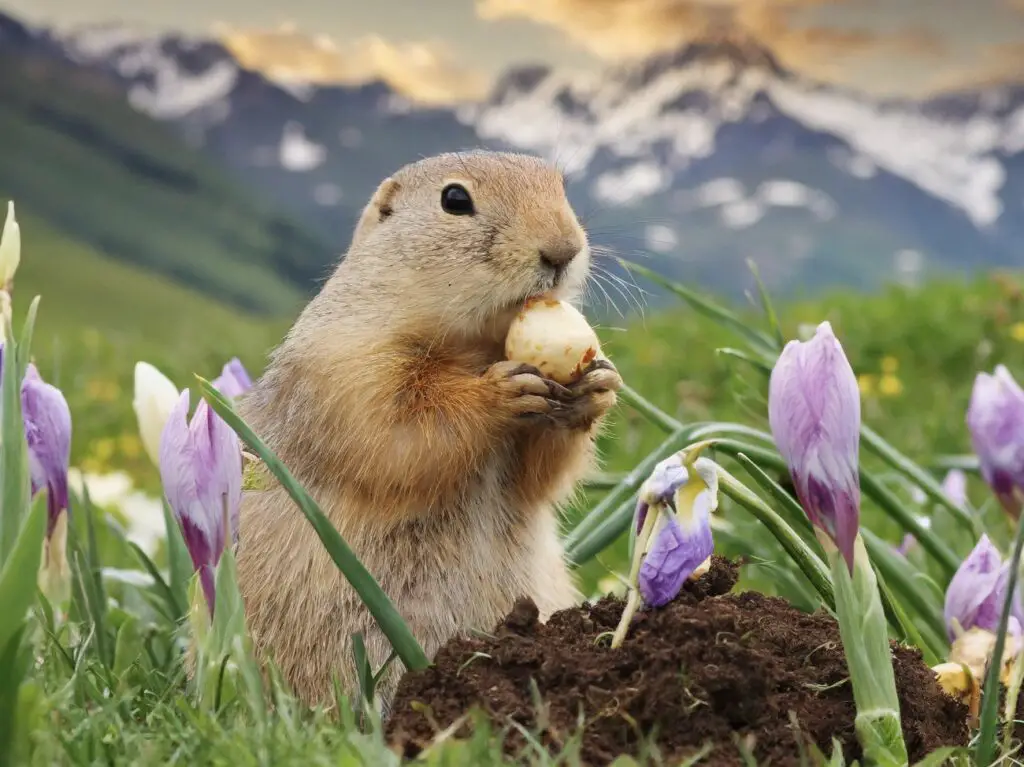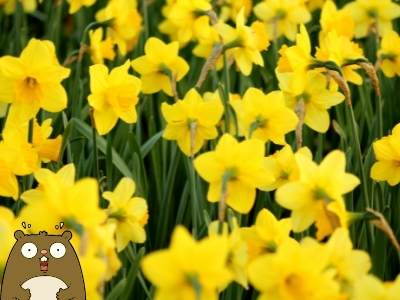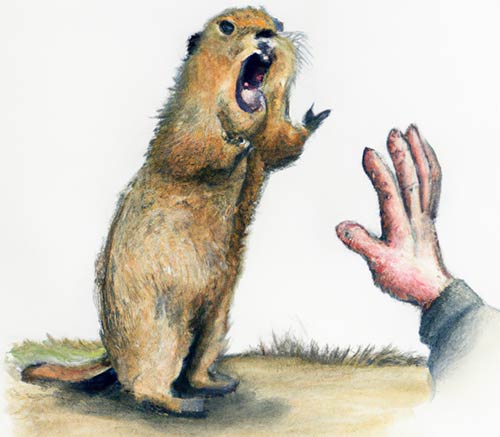Gophers are rodents that, just like their groundhog cousins, like to eat all kinds of plants!
They are considered pests by most gardeners, as they munch on many types of plants including flowers – especially their bulbs and seeds. However, there are indeed gopher-resistant flowers that can be used to protect and keep them away from more vulnerable flowers in your yard.
Apart from eating flowers, they feed on roots, tubers, bulbs, tree bark, and fallen fruit, and although rarely, some insects and smaller animals.
They are solitary animals that nest underground. Most active after dawn and before dusk, gophers create extensive tunnel systems with numerous exits to the surface.
Gophers generally avoid open spaces and cultivated areas, although they may live in these types of habitats.
Their homes are extensive tunnel systems that allow them to travel quickly from one end of their territory to the other without having to brave the elements or larger predators.
Although they come out mostly to eat, they can bite humans and pets and they will make a lot of mess when they dig around your yard – so take a look at these strategies to keep them away if needed!
What are Some Gopher-resistant Flowers?
Some flowers are not only pretty and will not be touched by gophers, but they can also be used to deter gophers from your other more susceptible plants!
Some good examples of flowers that gophers do not like are:
- Lavender (and other strongly scented flowers!)
- Rock Rose
- Fox Glove (highly toxic to animals!)
- Lantana
- Hawthorn
- Mint
- Sea thrift
- Daffodils (highly toxic to animals!)
- Wild lilac
- Rockrose
- Coreopsis
- Dianthus
- Geraniums
- Jasmine
- Siberian iris
- Honeysuckle
- Blue-eyed grass
- Star lily
These listed flowers can all be planted with good certainty that gophers won’t eat them, although depending on the gopher species (there are many!) there will be exceptions.
I will go through some of the most important questions on flowers and gophers below:
Do Gophers Eat Iris Bulbs?
Gophers are notorious for their voracious appetites and can pose a threat to various plants in your garden – including your Iris flowers and bulbs!

Among the many plants that may fall victim to these underground marauders, iris bulbs are not exempt from their menu.
Gophers are herbivores, primarily feeding on plant roots, bulbs, and tubers. They are known to consume a wide variety of vegetation, making them a potential threat to your garden plants, including iris bulbs. Gophers are especially active in the spring and fall, making these seasons critical times for protecting vulnerable plants.
Signs of Gopher Damage
Identifying gopher damage is crucial in taking timely action to safeguard your garden. Look out for mounds of soil, gnawed vegetation, and, in the case of iris bulbs, missing or damaged bulbs. Gophers are skilled diggers and can quickly undermine the health of your plants if left unchecked.
Protecting Iris Bulbs from Gophers
- Plant Bulbs in Protective Barriers: Consider planting your iris bulbs in wire mesh baskets or underground cages. This physical barrier can deter gophers from accessing the bulbs while allowing the plants to thrive.
- Use Repellents: Gopher repellents, available in various forms such as granules, sprays, or sonic devices, can help create an inhospitable environment for gophers. Natural repellents, like castor oil-based products, are environmentally friendly alternatives.
- Install Fencing: Installing underground fences made of hardware cloth around your garden area can be an effective way to keep gophers at bay. Make sure the fence extends below the soil surface to prevent gophers from burrowing underneath.
- Regular Monitoring and Trapping: Keep a close eye on your garden and set traps if you notice signs of gopher activity. Trapping can be an efficient method to control gopher populations and protect your iris bulbs.
In conclusion, gophers can indeed pose a threat to iris bulbs, but with proactive measures, you can minimize the risk of damage. Understanding gophers’ habits and employing protective strategies will help you maintain a flourishing garden. Whether through physical barriers, repellents, fencing, or trapping, there are various methods at your disposal to ensure that your iris bulbs remain safe from these persistent garden invaders. Stay vigilant and enjoy a garden filled with vibrant, healthy iris blooms.
Do Gophers Eat Daffodils?
No, gophers do not eat daffodils. This is because daffodils are poisonous due to a toxic element contained in the whole plant called lycorine.

Because of this, daffodils can be used to keep away gophers as the toxic compound has a bitter unpleasant taste that the gopher will remember.
Do Gophers Eat Daffodil Bulbs?
No, gophers do not eat daffodils or daffodil bulbs due to their toxicity. This is because the whole plant, including the bulb of the daffodil, is toxic and therefore not pleasant for the gopher to eat.
So planting daffodils in between your other plants will remind the gopher to stay away from that area, even when it approaches from below (which it often does!).
This is a useful technique especially if gophers or groundhogs have been eating the roots of your flowers as they cannot distinguish the roots of tasty flowers from those of the bitter/toxic daffodil roots when underground.
Do Gophers Eat Geraniums?
No, gophers don’t eat geraniums. The leaves are not a very desirable food source for gophers, who are more likely to eat roots underground. Geraniums have no pleasant taste or smell for gophers, and will not be consumed.
Do Gophers Eat Daylilies?
No, gophers do for some reason not like to eat daylilies. Although gophers are not likely to just stand on the surface and munch on a daylily, they may consume their roots if they find them underground. However, this does not happen very often and yard owners generally report that daylilies are left alone by gophers.

Daylilies are cultivated for their above-ground beauty but are usually planted with other plants. The best way to avoid this problem is to ensure that gopher-safe barriers are in place around the planting beds and plantings.
What are some flowers that gophers will sometimes eat?
Do Gophers Eat Dianthus?
No, gophers will not normally eat dianthus as they are slightly toxic.
Dianthus is part of the Caryophyllaceae family, with roots typically found closer to the surface than other plants. This tempts gophers to taste them, but they rarely follow through eating the whole plant.

There seems to be a bit of confusion about certain flowers out there because people report very mixed observations. This is most likely because there are some parts of the plants (e.g. bulbs) that are eaten or because they are eaten only at a certain growth stage (e.g. the sunflower).
Do Gophers Eat Iris Bulbs?
Yes. Contrary to popular belief, most gophers actually like iris flowers even though they have a strong scent!
Gophers often consume iris flowers in summer or their bulbs in winter if they find them underground.
Flower bulbs are readily available food for gophers during winter when gophers go into semi-hibernation and move around less due to the lack of food sources and lower temperatures.

Bulbs are easy targets for gophers in this case because they are preserved underground, making them difficult to detect by yard owners above ground.
The best way to avoid this problem is to have good gopher and groundhog deterring strategies in place near the planting beds and plantings.
Be sure that there’s no debris or vegetation growing close by as well, as these are likely locations for gophers to create tunnels and set up their territory.
Do Gophers Eat Dutch Iris?
Yes. Similar to other Iris species, gophers will eat Dutch iris, especially if they find them above their tunnels near the ground.
Most of the time, though, gopher activity is noticed after their tasty bulbs have been eaten and you’re left with a hole in the ground.
Dutch iris may be planted with other plants, as it tends to grow taller and make the gopher’s activity more noticeable.
Do Gophers Eat Sunflowers
Yes, gophers do eat sunflowers. Although gophers are not likely to just stand on the surface and munch on a sunflower due to the large size of the plant, they will consume them and their roots if they encounter them underground.
The best way to avoid this problem is to ensure that gopher-safe barriers are in place around the planting beds and plantings.
Be sure that there’s no sunflower that is falling down and make sure to keep them protected when young. You can support your sunflowers in a stake or cage so they don’t touch the ground.
How to Prevent Gophers from Eating your Flowers!
There are several methods for keeping gophers away from your flowering plants or vegetable garden.

Here is a list of my favorite methods!
1. Using ultrasonic sound
Gophers, like other pest mammals that may invade your garden, tend to have very good hearing. This means that loud or consistent noises will scare them away or at least shorten their visits.
Check out my full buying guide for these ingenious ultrasonic repeller devices here!
One of my favorite technologies to keep pests away from my backyard is these cool solar-powered ultrasonic sound emitters that you can buy right from Amazon! In my experience, they really work, and the solar panels on top save you the time and money of changing batteries all the time.
They will also work against rodents like gophers, mice, and rats!
2. Sprinkling natural repellents
Gophers may be scared off by using natural scents such as coyote urine or predator scents.
They may also cause them to leave if there is a combination of sounds being played from a radio. The sounds include the sound of barking dogs and coyotes.
You can sprinkle dog hair, cayenne pepper or strong enteric oils and other natural repellents around the garden to keep the groundhogs away.
See my complete list of humane ways to keep groundhogs away from your yard for more tips and tricks!
3. Fencing around the garden
You can also fence around your garden to keep gophers from entering the garden. It should be at least 3 feet deep and have a double row of fencing.
Groundhogs are good diggers so it has to go underground or they may find a way into the garden even with the fences in place!
4. Using live traps
You can use a live trap to capture gophers and move them to another area. Live trapping is currently the most humane way of groundhog control. Once you have removed all groundhogs from an area, it is important to ensure that they do not come back by using fencing or other barriers to block access.
You can also just buy a live trap, as the sturdy metal ones shown here:
To lure the groundhogs in, you can use one of the numerous favorite foods of groundhogs or an optimized extra attractive formula like this one to make the catch even quicker!
5. Using natural pesticides
There are pesticides or rodent toxins that can be used to kill groundhogs on your property. These may also affect other animals in the area so it is important to ensure that they are only sprayed on the targeted plants.
I do not recommend these, as I prefer more humane ways as described here. Also, anything that kills an animal will also harm humans to some degree, so go for a repellant rather than a toxin if you go the chemical route!
6. Using Scarecrows
You can use a scarecrow in your garden to keep groundhogs away. Groundhogs are afraid of novelty so time-sensitive or motion-activated scarecrows may also be effective in keeping them out of the garden.
7. Using Lights
Groundhogs are not strictly nocturnal animals but they are most active at low light so they do avoid areas with bright lights.
Motion-activated lights, sounds, and sprinklers may help prevent groundhogs from entering your yard.
Any blinking light will confuse and scare away groundhogs from your yard, especially if they are motion activated and sudden!
8. Motion-activated sprinklers
Like most animals, groundhogs hate surprises, and they will run away if suddenly sprayed with water. I like this solution because it is humane, simple, effective, and does not require much time to set up.
The Havahart 5277 is a motion-activated sprinkler that is activated by the movement of animals up to 25 feet away and sprays them with a harmless water jet, frightening them off and keeping them at bay.
The included metal stake makes it easy to install in your garden, and the sprinkler can be rotated 180 degrees for maximum coverage.
In summary
Gophers will eat a variety of flowers, but they prefer to munch on bulbs and roots that grow close to the surface. Keep this in mind when planting around gopher territory and you’ll be able to keep these hungry rodents out of your beds.
Gophers are rarely found in well-kept lawns that are free of debris or vegetation growing around their burrows.
However, the best way to avoid being a victim of gopher damage is to have a gopher-safe barrier in place around your planting beds.
This will serve as the first line of defense against the hungry little buggers and keep them from chowing down on your favorite plants.
If you are interested in learning some key strategies to keep gophers and other rodent pests out of your backyard – check out my list on the best ways to do so here!















